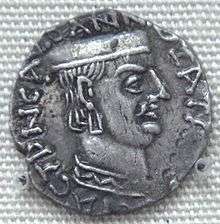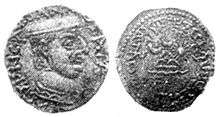Chashtana
| Chashtana | |
|---|---|
| Mahakshatrapa Bhadramukha Swami[1] | |
 Silver coin of Chashtana, with ruler profile and pseudo-Greek legend. British Museum. | |
| Reign | 78-130 CE |
| Dynasty | Kardamaka (Western Satrap) |

Chashtana (IAST: Caṣṭana, or Chastana) was a ruler of the Saka Western Satraps in northwestern India during 78-130 CE.[2] He was satrap of Ujjain during that period. Among the modern scholars, the beginning of the Saka era is widely equated to the ascension of Chashtana (possibly to Mahakshatrapa) in 78 CE.[3]
A statue found in Mathura together with statues of the Kushan king Kanishka and Vima Taktu, and bearing the name "Shastana" is often attributed to Chashtana himself. Chashtana is called Tisman by the bards, a spelling that matches the Greek rendition of his name more closely.
Chashtana was mentioned by Ptolemy as "Tiasthenes" or "Testenes", ruling a large area of Western India into the 2nd century CE, especially the area of Ujjain ("Ozene"), during the reign of the Satavahana king Vasisthiputra Sri Pulamavi. According to Ptolemy, Chashtana directly ruled Ujjain, while Paithan (Pratisthana) continued to be ruled by Siristolemaios (identified with Sri Pulumayi, son of Gautamiputra Satakarni).[4] Ptolemy in his "Geographia", where he qualifies the Western Satraps as "Indo-Scythians", describes Chashtana's territory as starting from Patalene in the West, to his capital Ujjain in the east ("Ozena-Regia Tiastani", "Ozene, capital of king Chashtana"), and beyond Barigaza in the south:
Moreover the region which is next to the western part of India, is called Indoscythia. A part of this region around the (Indus) river mouth is Patalena, above which is Abiria. That which is about the mouth of the Indus and the Canthicolpus bay is called Syrastrena. (...) In the island formed by this river are the cities Pantala, Barbaria. (...) The Larica region of Indoscythia is located eastward from the swamp near the sea, in which on the west of the Namadus river is the interior city of Barygaza emporium. On the east side of the river (...) Ozena-Regia Tiastani (...) Minagara".— Ptolemy Geographia, Book Seven, Chapter I
Chashtana was the grandfather of the great Western Satrap conqueror Rudradaman I. Chashtana was founder of one of the two major Saka Satrap dynasties in north-western India; the other, short-lived dynasty included Bhumaka and Nahapana.[5]
References
- ↑ Burgess 1880, p. 189.
- ↑ Elizabeth Errington, Vesta Sarkhosh Curtis, ed. (2007). From Persepolis to the Punjab. British Museum Press. ISBN 9780714111650.
- ↑ Shailendra Bhandare (2006). "Numismatics and History: The Maurya-Gupta interlude in the Gangetic Plains". In Patrick Olivelle. Between the Empires : Society in India 300 BCE to 400 CE: Society in India 300 BCE to 400 CE. Oxford University Press. p. 69. ISBN 9780199775071.
- ↑ Alain Danielou, A Brief History of India (Inner Traditions, 2003), mentioned here
- ↑ Students' Britannica India. 4. Encyclopædia Britannica. 2000. p. 375.
Bibliography
- "The dynastic art of the Kushans", Rosenfield
- Burgess, James (1880). The Cave Temples of India. Cambridge University Press. ISBN 978-1-108-05552-9.
| Preceded by |
Western Satrap 130 CE |
Succeeded by Jayadaman |